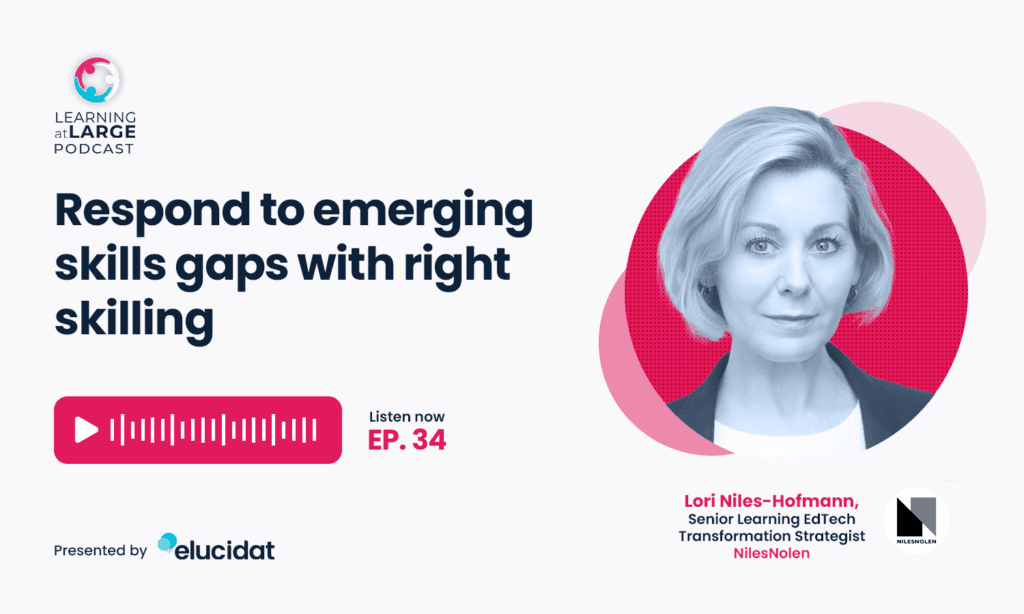Respond To Skills Gaps: Lori Niles-Hofmann
2021 was the year of the ‘Great Resignation’. People quit their jobs at historic rates and they moved in to new roles and different fields. As L&D adjusts to this new landscape, upskilling and reskilling are the go-to phrases. But have you thought about right skilling? Hear how Lori Niles-Hofmann, Senior Learning EdTech Transformation Strategist at NilesNolen, focuses on the skills that provide the most value. Discover how to identify the real business and employee needs, find out why collaboration is the key to success, and explore how to support people on a new kind of career path.

Top tips to focus on the skills that matter
Don’t have time to listen now? Here are some top tips from Lori Niles-Hofmann:
- Think right skilling, not reskilling: Often inflexible and generic, reskilling and upskilling have limited impact. Target the real business needs by right skilling.
- Dig deeper to discover the real needs: Move beyond assumptions about what people need. Gather data that identifies the right skills for the business and employees.
- Don’t go it alone; collaborate: The L&D team can’t develop the right skills in isolation. Build relationships that help you understand the skills you need and already have.
- Embrace exploratory career paths: Careers don’t have to be a linear progression upwards. Support exploratory pathways with personalized learning and support.
1. Think right skilling, not reskilling
Faced with high employee turnover and rapid change, it’s no wonder emerging skills gaps are a hot topic. Many businesses have seen reskilling and upskilling as the answer. But this can often focus on a narrow idea of the core skills that everyone needs.
Lori believes this inflexible, ‘one size fits all’ view will always have a limited impact. Instead, she proposes a new approach: right skilling. It’s about targeting the real business needs. Focus your efforts where they can have most impact. Be ready to pivot your ideas as your organization and employees change direction.
“Right skilling is looking at the gaps that you have as an organization in order to pivot as a company. What skills don’t you have? What do you need to develop? What skills are not available in the market? And how do you match that with a learning strategy to ensure that your employees are right skilled to those competencies?”
2. Dig deeper to discover the real needs
Whether it’s upskilling or reskilling, training won’t be effective if it isn’t in response to a real business need. Don’t waste everyone’s effort by focusing on skills that will have little or no impact. Move beyond what people think is needed. Gather data that identifies the right skills for your business and people
A training need will often be communicated from the top. Don’t just move ahead with a solution at someone’s suggestion. Dig a little deeper. Start by identifying your gaps and work backwards.
“You begin by talking to [the business]… Asking what gaps do you have? Some people will be very open because you’re resolving a pain point… [But you also] have to do your own digging. Go on LinkedIn, or Indeed, or any place where your company posts roles. Look at the ones that have been open for more than six weeks. What skills are required? Then see if you have a pipeline for those skills.”
3. Don’t go it alone; collaborate
Developing the right skills can’t be done by the L&D team alone. For Lori, good relationships and open conversations are essential to your success.
Listen to the managers because they know the business. Talk to employees who understand the real pain points that they face. Work with talent management to map the current skills landscape and identify your options for filling any gaps. Create an inventory of all the skills in your organization. Even if a skill isn’t relevant in one role, it might be essential in another area.
“Think of yourselves as a pizza factory, and you need tomatoes. Well, on the one hand, do you buy the tomatoes on the market? What’s the cost? Do you have to import them? What’s the quality that year of the crop? Or do you grow them? And what does it take to grow them? And what do you need? A greenhouse? And what’s the length of time? Think like that about skills. That’s how you need to be working with talent management.”
4. Embrace exploratory career paths
By right skilling, you’re hiring the most suitable people, mitigating risk and saving money. This all contributes to your organization’s strategy. But it’s not just about the business benefits. You’re also doing the right thing for employees. You’re not adding to the noise and stress with lots of ineffective training. You’re helping them to get the skills that they need to stay relevant in their role and on the job market.
Lori believes we need to embrace the idea that people can, and should, change career direction. That means moving sideways and diagonally, as well as upwards, in organizations. Career paths should be much more exploratory. You need to encourage and support this with personalized learning experience. Offer the practise opportunities and coaching people need to succeed in their careers.
“I’m not talking about shoving people into roles that they don’t want. I’m talking about sparking curiosity about things that they’re interested in, and that maybe wouldn’t have been presented to them [because of] the role that they’re currently in. So, it’s helping people make those big leaps into different career paths. Because that’s, that’s just going to have to happen. So, let’s give people those skills to do that.”
A quick recap
Faced with an ever-changing skills landscape, Lori has developed a new approach: right skilling. She has four strategies for focusing on the areas that provide most value for everyone. Forget reskilling and upskilling; always think right skilling. Get up close and personal to business needs. Collaborate with your colleagues and peers to identify those killer skill gaps and how to fill them. Support new exploratory career paths with personalized learning.
About Lori
With over 25 years’ experience as an EdTech Strategist across various industries, Lori is a key L&D thought and habit shaker and maker. She’s half of NilesNolen, who provide expert-led consultancy and honest, business-critical support.
You can find out more and get connected with Lori on LinkedIn.
On Lori’s reading list
Find out which book has inspired Lori’s approach to learning and leadership.
Lead. Care. Win.: How to Become a Leader Who Matters, Dan Pontefract
This is not just a book. It’s a complete immersive learning experience with practice and social elements. It focuses on leading with empathy and compassion. This book helped Lori look at leadership through a very different lens.
Looking for more reading tips? Check out our L&D book recommendations.
Join the conversation!
We’d love to hear your thoughts on our podcast, so feel free to get in touch with our podcast. As always, don’t forget to subscribe to Learning at Large in your favorite podcast app and leave us a 5-star rating if you enjoyed it. Thank you for joining us, and see you next time.

